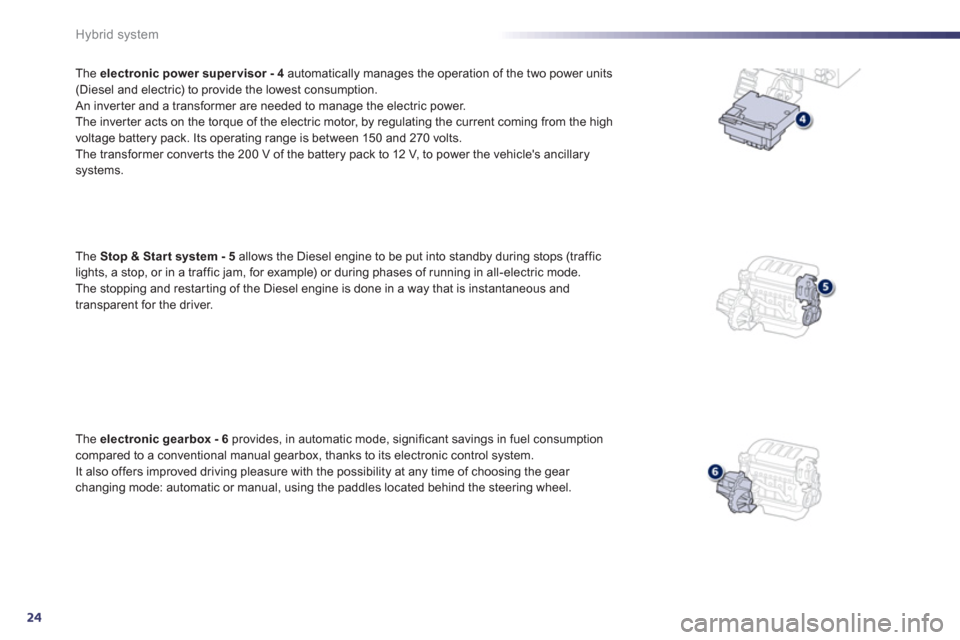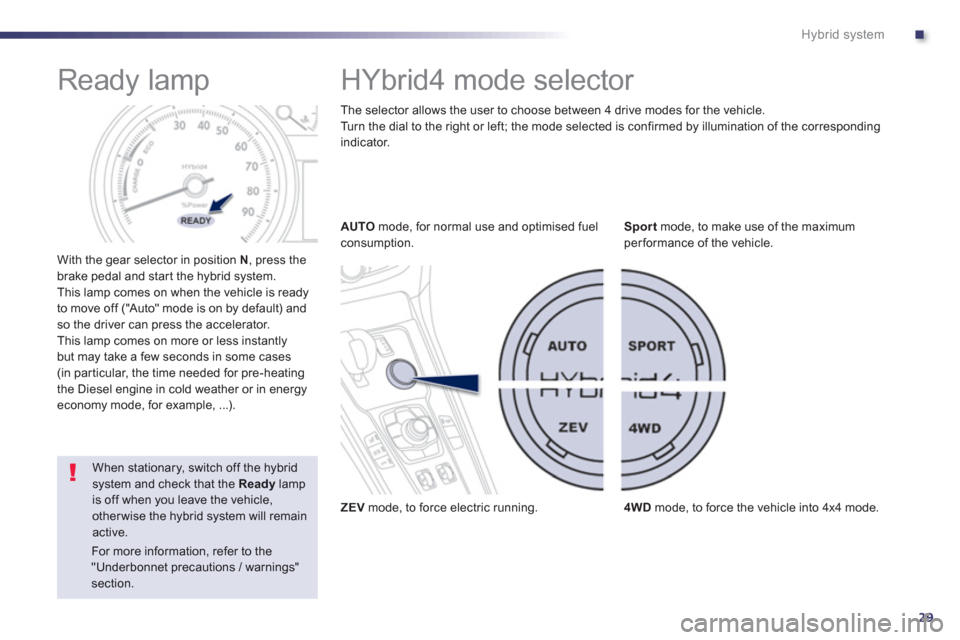Page 4 of 304

.
.
Contents
Instrument panel 45
Indicator and warning lamps 46
Gauges and indicators 57
Tr ip computer 62
Setting the date and time 65
Instruments and controlsFamiliarisation
Remote control key 66
Alarm 76
Electric windows 78
Boot 80
Motorised tailgate 81
Panoramic sunroof 84
Fuel tank 85
Diesel misfuel prevention 86
Access
Front seats 88
Rear seats 92
Mirrors 94
Steering wheel adjustment 96
Interior fi ttings 97
Boot fi ttings 100
Heating and Ventilation 106
Dual-zone digital air conditioning 108
Quad-zone digital air conditioning 111
Rear screen demist - defrost 116
Programmable Heating / Ventilation 117
Comfort
Electric parking brake 119
6-speed electronic gearbox 126
Hill star t assist 130
Head-up display 131
Speed limiter 134
Cruise control 136
Parking sensors 138
Parking space sensors 140
Driving
Lighting controls 142
LED lamps 145
Automatic illumination of headlamps 147
Headlamp adjustment 150
Directional lighting 151
Wiper controls 152
Automatic rain sensitive wipers 154
Cour tesy lamps 156
Interior mood lighting 157
Visibility Hybrid system
Presentation 22
Starting / switching off 25
Ready lamp 29
HYbrid4 mode selector 29
Energy consumption / generation indicator 32
Display of hybrid power fl ow 33
Eco off 36
Eco-driving 37
Consumption 39
High voltage battery 40
Vehicle recovery 44
Page 5 of 304
.
.
Contents
Child seats 158
ISOFIX child seats 164
Child lock 167
Child safety
Direction indicators 168
Emergency or assistance call 169
Horn 169
ESP system 170
Seat belts 173
Airbags 176
Safety
Te m p o r a ry puncture repair kit 180
Changing a wheel 186
Changing a bulb 191
Changing a fuse 198
12 V battery 202
Energy economy mode 205
Changing a wiper blade 206
Recovering the vehicle 207
Vehicle recovery 209
To w i ng a trailer 210
Fitting roof bars 212
Accessories 213
Practical information
Opening the bonnet 216
Running out of fuel (Diesel) 217
Diesel engine 218
Checking levels 219
Checks 222
Checks
Electric motor 225
Diesel engine 226
Diesel weights 227
Dimensions 228
Identifi cation markings 229
Technical data
Emergency or assistance 231
JBL equipment 233
Peugeot Connect Navigation (RT6) 235
Audio equipment and telematics
Alphabetical index
Visual search
Page 7 of 304

.
5
Familiarisation
For economical driving, caring for the environment
The fuel consumptionof a vehicle varies greatly:
- according to the driver's style of driving
(moderate, aggressive, fast, ...),
- according to the type of journeys
made (urban, main road, motorway, flowing, heavy traffic, …) and the speed.
Main recommendations for driving economically
Hybrid mode selector
To optimise fuel consumption, use the Automodeof the selector whenever possible (the mode is activated
automatically when starting) including for urban journeys.
This mode optimises the use of the energy sources (internal combustion engine and/or electric) contrary to other modes, which are for use in par ticular cases.
Gear lever
Use the automatic
mode A
as much as possible as this optimises gear changes to suit the requirements.
Drive smoothly
Stay in the "eco" zone
displayed in the energy consumption / generation indicator: accelerate gently, drive atsteady speeds using the speed limiter or cruise control as soon as possible. Use the "charge" zone: anticipate the need to slow down by taking your foot off the accelerator rather than
braking. The movement of the energy consumption / generation indicator needle (into the "charge" zone), shows
the level of energy recovery.
Consumption history
See the impact of your style of driving and the type of journey by reviewing the history of your energyconsumption. Refer to the "Multifunction screens" section.
Causes of high consumption and checks
As with any vehicle, limit overloading, wind resistance (windows open above 30 mph (50 km/h), roof rack, loaded
or not, …), the use of power consumers (air conditioning, heated seats, heated rear screen, …).
Obser ve the recommendations on checks (regular check of tyre pressures, correct tyre pressures, …) and routine servicing.
Page 10 of 304
8
Familiarisation
Opening
A.
Unfolding / Folding the key.B.Unlocking the vehicle.
Remote control key
1.Opening the fuel filler flap.
Fuel t ank
85
2.Opening and hooking the fuel filler cap.
Tank capacity: approximately 72 litres. Other functions...C.Normal locking of the vehicle Vehicle location.
6
6
Page 12 of 304
10
Familiarisation
Illumination of the lamp indicates the state of
the corresponding function.
Switch panels
Electric parking brake.
Opening the boot.
119
Massage.
91
76
Al
arm.
El
ectric child lock.
69
, 80
167
Peu
geot Connect SOS
231
Starting/stopping using the electronic
key.
25/26
Deactivation of parking sensors.
139
Inhibition of internal combustion engine stop.
36
Programmable heating warning lamp.
117
Parkin
g space sensor.
140
Deactivation o
f the DSC system.
172
Opening the fuel filler flap.
85
Adaptive lighting
148
Head-up displa
y (on/off, settings).
13
1
Page 19 of 304
.
17
Familiarisation
Monitoring
On switching on, the dial needles go to the extent of their travel then return to 0.
A.With the ignition on, the needle should
indicate the fuel remaining.B.With the engine running, the associatedlow level warning lamp should go off.
Instrument panel
1.
With the ignition on, the orange and red
warning lamps come on. 2.With the engine running, these warninglamps should go off.
If a warning lamp remains on, refer to the page concerned.
Warning lamps
46
C.
With the ignition on, the instrument panelscreen should indicate the oil level.
If the levels are not correct, top up the level
which is low.
45
Page 26 of 304

24
Hybrid system
The electronic power super visor - 4automatically manages the operation of the two power units(Diesel and electric) to provide the lowest consumption.
An inver ter and a transformer are needed to manage the electric power.
The inver ter acts on the torque of the electric motor, by regulating the current coming from the high
voltage battery pack. Its operating range is between 150 and 270 volts.
The trans
former conver ts the 200 V of the battery pack to 12 V, to power the vehicle's ancillary
systems.
Th
e Stop & Star t system - 5
allows the Diesel engine to be put into standby during stops (traffic
lights, a stop, or in a traffic jam, for example) or during phases of running in all-electric mode.
The stopping and restar ting of the Diesel engine is done in a way that is instantaneous and
transparent for the driver.
Th
e electronicgearbox - 6provides, in automatic mode, significant savings in fuel consumption compared to a conventional manual gearbox, thanks to its electronic control system.
It also offers improved driving pleasure with the possibility at any time of choosing the gear changing mode: automatic or manual, using the paddles located behind the steering wheel.
Page 31 of 304

.
29
Hybrid system
Ready lamp
With the gear selector in position N, press the
brake pedal and star t the hybrid system.
This lamp comes on when the vehicle is read
y
to move off ("Auto" mode is on by default) andso the driver can press the accelerator.
This lamp comes on more or less instantlybut may take a few seconds in some cases (in par ticular, the time needed for pre-heating
the Diesel engine in cold weather or in energy economy mode, for example, ...).
HYbrid4 mode selector
AUTOmode, for normal use and optimised fuelconsumption.
ZEVmode, to force electric running.S
portmode, to make use of the maximum
performance of the vehicle.
4WDmode, to force the vehicle into 4x4 mode.
When stationary, switch off the hybridsystem and check that the Readylamp is off when you leave the vehicle,otherwise the hybrid system will remainactive. Th
e selector allows the user to choose between 4 drive modes for the vehicle.
Turn the dial to the right or left; the mode selected is confirmed by illumination of the corresponding indicator.
For more information, refer to the "Underbonnet precautions / warnings" section.